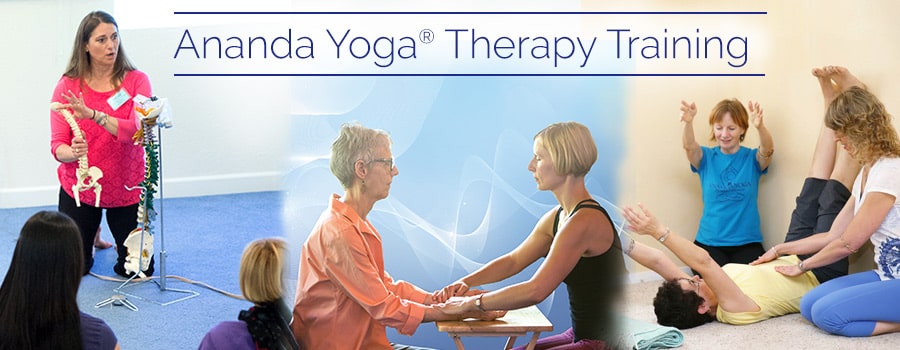SYLLABUS
Restorative Ananda Yoga® Teacher Training
We are not currently accepting new students in the Ananda Yoga Therapy Training
Course Hours: Total = 30 (Residential and Distance)
- Residential: 22 (with 5 hours Practicum)
- Distance: 8 (as Home Practicum)
- Practicum: 13 (5 Residential; 8 Distance)
Prerequisite
Graduate of Ananda Yoga® Teacher Training (200-hour), or
Graduate of a Yoga Alliance approved 200-hour Yoga Teacher Training
Teaching Format
This is a 3-day residential course which includes a combination of lecture, discussion, experiential, practice teaching of restorative yoga asanas for individuals and small groups, and student teaching and practicum (residential). Students also complete a home practicum assignment.
Faculty
Melody Hansen, E-RYT-500, Certified Ananda Yoga Teacher 200 & 500, Certified Meditation Teacher, Ananda Yoga Therapist, C-IAYT
Required Texts/Reading Materials
Reading assignments (sections 1 – 7) from the Restorative Yoga Teacher Training manual, which includes fully illustrated photos of the asanas and their props by Barbara Bingham, instructions and guidelines for: teaching, assisting and adjusting students in the asanas, cautions/contraindications and modifications for asanas, plus handouts written by Ananda Faculty, articles, research papers, excerpts from the Ananda YTT 200 manual, and other resources. This manual is included with the course.
Course Description
On two evenings of the course we have the students teach a yoga therapy restorative yoga class to a large group of volunteer clients, and to individualized clients. Both these sessions are supervised under senior faculty observation, and require students to present a pose to the entire group while catering to the individual needs of their private client. Each student is evaluated by the faculty and given written feedback on how to improve in their teaching skills for the next class and in general. The following day, students are given time to share their experiences and discuss their cases and the course of actions they took in order to improve their client’s experience. On the final day, there is a quiz that is graded in class so both students and faculty know what needs to be reviewed or expanded upon.
Though this course focus is on restorative yoga, other areas of study and of yoga therapy (such as Pranayama, Chakras, Chanting, and meditation) are brought into the discussion, instruction and practice.
Common cautions and contraindications and/or injuries are covered as related to each restorative asana. Students will participate in and be assigned one or more student/clients to work with for two 2 hour sessions under supervision of senior faculty. Students will prepare and give a presentation of two different asanas and how to modify props to meet individual needs, and then practice assisting and adjusting with their client.
Learning Objectives
At the completion of the course, students will know:
- How to be a safe, supportive, and conscientious Restorative Yoga Teacher
- How to sequence an Ananda Yoga Restorative Routine in a therapeutic way that enhances the well-being of the practitioner on all levels and follows the ultimate aim of the ancient science of Raja Yoga
- How to teach 2 coherent Ananda Yoga Restorative Routines (with appropriate modifications as needed by individuals) including the guidance and instruction of: Breathing, Posture, Proper Alignment, Safety mechanics for asanas and the common cautions and contraindications
- How to demonstrate restorative yoga asanas and their common modifications and variations needed for students with or without special conditions
- How to explain the common conditions/cautions and/or complaints a student may experience in a restorative pose and know how to individually assist these students in the asanas so that they are practicing safely and comfortably
- How to use the breath to invoke the Relaxation Response
- How to practice with a variety of props you will actually be using in real-life situations
- How to experience and student-teach restorative poses that focus on releasing specific physical and mental tensions
- How to use affirmations, visualizations, meditation, and music to deepen your own and your students’ practice of Restorative Yoga
- How to work one-on-one with 2 or more yoga clients who need individual assistance and modifications
Course Completion Requirements:
Students have demonstrated understanding of course learning objectives by their supervised practicum, attendance at all lectures, participation in practice teaching & team-teaching sessions, and all asana workshops. In addition, the completion of reading assignments (Sections 1 – 7) in the restorative teacher training manual, and satisfactory performance on the final quiz (80%), are required.
PLEASE NOTE—The following information pertains ONLY to those who are taking this course as part of Ananda Yoga Therapy Training:
Satisfactory completion of Home Practice Assignment is also required for those enrolled in the Ananda Yoga Therapy Training program.
- Students are given written feedback by supervising faculty, along with an offer to speak in person or by phone in addition. If the expected standard of satisfactory performance (set by IAYT Standards and Competencies) is not met, then students will be given additional guidance and assignments as needed until they can demonstrate the expected competency.
- If any of the above requirements or expectations are not met, the student will be counseled and/or given additional assignments in order to help them be able to demonstrate satisfactory performance.
Subject Matter/IAYT Competencies Covered:
The main focus of this course covers the broad categories of 2.5 Body and Mind Integration, 3.1 Basic Principles of Therapeutic Relationship, 3.2 Principles and Skills for Educating Clients/Students, 3.3 Principles and Skills for Working in Groups, 4.0 Yoga Therapy Tools, 4.1 Yoga Practices and their Application and Practicum in the restorative yoga context. Below are the competencies covered:
Section 2. Biomedical and Psychological Foundations
Category 2.1. Anatomy and Physiology
2.1.2. Knowledge of biomechanics and movement as they relate to the practice of yoga and the work of a yoga therapist.
2.1.3. Knowledge of common pathologies and disorders of all the major systems, including symptoms, management, illness trajectories, and contraindications,
as relevant to the work of a yoga therapist.
Category 2.2. Additional Biomedical Knowledge
2.2.2. Familiarity with common medical terminology.
Category 2.4. Additional Knowledge
2.4.2. Familiarity with the influence of familial, social, cultural, and religious conditioning on mental and medical perspectives of health and healing.
Category 2.5. Body and Mind Integration
2.5.1. Knowledge of the interaction of the body, breath, mind, intellect, and emotions in health and well-being.
Section 3. Yoga Therapy Tools and Therapeutic Skills
Category 3.1. Yoga Therapy Tools
3.1.1. In-depth knowledge of the application of yama and niyama in the context of yoga therapy.
3.1.2. In-depth knowledge of the range of yoga practices and their potential therapeutic effects for common conditions Practices may include, but are not limited to,
3.1.2.1. Asana (postures);
3.1.2.2. Pranayama (regulated breathing);
3.1.2.3. Meditation and relaxation techniques such as bhavana (visualization), mantra (recitation),
3.1.3 In-depth knowledge of contraindications of yoga practices for specific conditions and circumstances.
Category 3.2. Basic Principles of the Therapeutic Relationship
3.2.1. In depth knowledge of, and observed capacity for, well-developed communication skills: listening, presence, directive and non-directive dialogue..
3.2.2. Demonstrated ability to recognize, adjust, and adapt to specific client/student needs in the evolving therapeutic/professional relationship
3.2.3. Demonstrated ability to recognize and manage the subtle dynamics inherent in the therapist/client relationship.
Category 3.3. Principles and Skills for Educating Clients/Students
3.3.1. In-depth knowledge of and demonstrated ability to implement effective teaching methods, adapt to unique styles of learning, provide supportive and effective feedback, acknowledge the client's/student's progress, and cope with unique difficulties/successes.
3.3.2. In-depth knowledge of and demonstrated ability to transmit the value of self-awareness and self- responsibility throughout the therapeutic process.
3.3.3. In-depth knowledge of and demonstrated ability to develop and adjust appropriate practice strategies to the client/student.
Category 3.4. Principles and Skills for Working with Groups
3.4.1 Basic knowledge of and demonstrated ability to design, implement, and evaluate group programs.
3.4.2. Familiarity with group dynamics and techniques, including communication skills, time management, and the establishment of priorities and boundaries, as well as techniques to address the specific needs of individual participants, to the degree possible in a group setting.
Section 4. Practicum
Category 4.1. Provide Yoga Therapy
4.1.1 Demonstrated ability to conduct intake and assess the client/student, including
4.1.1.1. Taking a history of the client and his/her condition(s); and
4.1.1.2. Assessing the current condition using the tools relevant to the yoga therapist, including an evaluation of the physical, energetic, mental, emotional, and spiritual dimensions of well-being.
4.1.2. Demonstrated ability to elicit the goals, expectations, and aspirations of the client/student.
4.1.3. Demonstrated ability to integrate information from the intake, evaluation, and observation to develop a working assessment of the client's condition, limitations, and possibilities.
4.1.4. Demonstrated ability to apply knowledge of how to determine which aspects of the client/student's conditions, goals, and aspirations might be addressed through yoga therapy.
4.1.8. Demonstrated ability to apply knowledge of how to combine intake, evaluation, observations, and working assessment to develop an appropriate practice or session strategy for individual clients/students as well as group classes, taking into consideration the holistic nature of the individual.
4.1.9. Demonstrated knowledge of how to choose and prioritize the use of yoga tools and techniques, including selecting, sequencing, adapting, and modifying yoga practices appropriate to the needs of clients.
4.1.10. Demonstrated ability to teach or deliver the appropriate practices for individuals as well as groups, taking into consideration the assessment of their conditions, limitations, possibilities, and the overall practice strategy.
4.1.11. Demonstrated ability to facilitate the client/student's experience of the practice, including
4.1.11.1. Providing instruction, demonstration, education of the client/student using multimodal strategies of education such as auditory, visual, and kinesthetic learning tools; and
4.1.11.2. Providing supportive strategies for the client/student to actively participate in his/her practice, such as a means to remember his/her practice (e.g., auditory and visual tools).
4.1.12. Demonstrated ability to develop and maintain therapeutic relationships including
4.2.12.1. Fostering trust by establishing an appropriate therapeutic environment through privacy, confidentiality, and safety; and
4.1.12.2. Practicing effective, client/student-centered communication based upon a respect for, and sensitivity to, individual, familial, cultural, social, ethnic, and religious factors.
4.1.13.1. Gathering feedback, re-assess, and refine the practice and to determine short-term and long-term goals and priorities;
4.1.13.2. Addressing new and changing conditions, goals, aspirations, and priorities of the student/client and to provide appropriate support; and
4.1.13.3. Providing appropriate closure for the therapy sessions.
Section 5. Professional Practice
Category 5.1. Ethical Principles
5.1.1 In-depth knowledge of yoga practices and methods for self-inquiry related to establishing, practicing, and maintaining ethical principles.
5.1.2 In-depth knowledge of generally accepted ethical principles of health care codes of conduct and yoga’s ethical principles.
Ananda Yoga Therapy Training
- Overview
- Flow Chart of Ananda Yoga® Therapy Training Courses
- Course Syllabi
- Tuition Costs
- Ananda Yoga® Therapy Training Courses Scheduled
- Frequent Questions
- Instructors
- Apply for Level 1
- Student Handbook with Costs
- Bridge to Ananda Yoga
Upcoming Courses in date order
- Restorative Ananda Yoga® Teacher Training - In Person
- Ananda Yoga® Advanced Training: Therapeutic Yoga for Seniors and Bone Strength
- Ananda Yoga® Assistantship
- Bhagavad Gita Retreat
- The Essence of the Yoga Sutras According to Paramhansa Yogananda
- Ananda Meditation® Teacher Training - In Person
- Advanced Pranayama
- Ananda Yoga® Therapy Training: Principles
- Ananda Yoga® Therapy Training: Musculoskeletal–1
- Ananda Yoga® Therapy Training Online: Ayurveda
- Ananda Yoga® Therapy Training Online: Health Challenges–1
- Ananda Meditation® Solutions
- Ananda Spiritual Counseling® Training - In Person
- Ananda Yoga® Therapy Training: Musculoskeletal–2
- Ananda Yoga® Therapy Training Online: Health Challenges–2
- Ananda Yoga® Therapy Training: Psychology and Mental Health
- Ananda Yoga® Therapy Training: Holistic Health Therapist Training
Nursing CEU Eligible: details coming

How to Choose a
Yoga Teacher Training Program
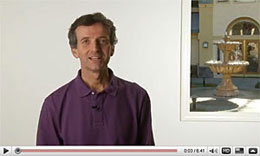
“My 4 weeks of Ananda Yoga Teacher Training was one of the most fulfilling and spiritually transforming periods in my life. All of the faculty, along with the entire Ananda community, were very supportive and nurturing.” – R. F., Lake Bluff, IL.

Testimonial for the Ananda Yoga Therapy Training Program
“The program is all embracing ˜ asana, ayurveda, chakras, special health issues touching on body, mind, and spirit. The instructors were wonderful, knowledgeable, supportive, and enthusiastic.” – T.C., CA.


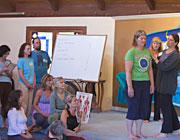

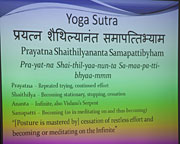
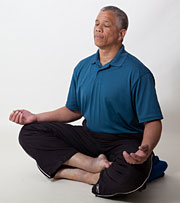
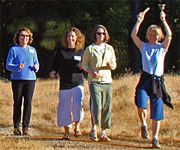
The yoga therapy components of these courses are based on our accreditation by IAYT, not derived from our status as an RYS with Yoga Alliance Registry.


CONNECT
14618 Tyler Foote Rd
Nevada City, California 95959
Toll free 800-346-5350
Outside US 530-478-7518
LEARN MORE
SUBSCRIBE
Receive uplifting emails with inspirational content and news about our retreat programs, travels, and trainings.



